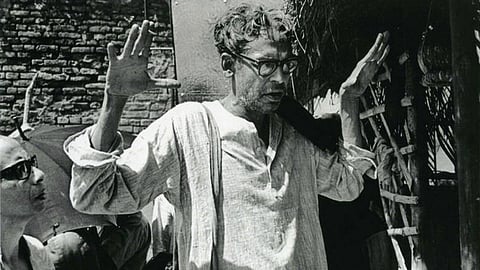
- HOMEGROWN WORLD
- #HGCREATORS
- #HGEXPLORE
- #HGVOICES
- #HGSHOP
- CAREERS
- ABOUT US
- CONTACT US

“In our boyhood, we have seen a Bengal, whole and glorious… [but after partition] our dreams faded away. We crashed on our faces, clinging to the crumbling Bengal, divested of all its glory.”
— Ritwik Ghatak (1925-1976)
Ritwik Ghatak was very much a product of his life and time — of partition and all that came before and after. Often hailed as a filmmakers' filmmaker, his genius, however, was not restricted to his own films and scripts alone but went on to influence a generation of filmmakers. As we live through a time of unprecedented global crises — war, culture war, climate collapse, genocide, and geopolitical upheavals — leading to mass migrations and displaced populations across the world, his films about the social realities of partition and migration remain as relevant as ever. Monday, November 4, 2024, was the hundredth anniversary of his birth.
Largely overshadowed by contemporary Bengali filmmakers like Satyajit Ray and Mrinal Sen during his lifetime, Ritwik Ghatak was a pioneer of parallel or New Indian Cinema — a film movement inspired by Italian neorealism that originated in West Bengal in the 1950s and brought social realism and naturalism to Indian cinema. Ghatak shaped much of the post-independence Indian Bengali alternative cinema scene and influenced generations of Bengali and Hindi independent filmmakers who came after him. He was a master of social realism, and his work dealt with the brutal realities and human cost of partition in post-independence India.
In 1958, he made his directorial debut with the film adaptation of ‘Ajantrik’, a short story by Bengali author Subodh Ghosh, that depicts the relationship between Bimal, a taxi driver in a small provincial town in Bengal, and his run-down 1920s Chevrolet Jalopy taxicab, his only companion and possession, which he lovingly names 'Jagaddal' — a Bengali word that translates to ‘awkward,’ or ‘pathetic’. It’s a brilliant piece of modernist cinema that is still relevant in its revelatory portrayal of the ever-complicated relationship between man and machine, and the tension between ethereal nature and mechanized industrial civilization.
After 'Ajantrik' and the coming-of-age film 'Bari Theke Paliye' (The Runaway, 1959), Ghatak turned his cinematic gaze to the partition of India into essentially three countries — India, Pakistan, and East Pakistan, which would later become present-day Bangladesh. His partition trilogy — 'Meghe Dhaka Tara' (The Cloud-Capped Star, 1960), 'Komal Gandhar' (E-Flat, 1961), and 'Subarnarekha' (The Golden Line, 1965) — depicts the fallout of this colonial geopolitical exercise and draws from his personal experience of partition as a young immigrant. Ghatak was born in Jindabazar, Dhaka, in present-day Bangladesh, and grew up between Dhaka and Kolkata, the cultural centres of East and West Bengal.
Before Ghatak, there had been depictions of partition in Indian film and literature through the horrors of the partition of Punjab between India and Pakistan — often portrayed through the genocidal imagery of trains full of corpses coming in and out of Lahore and New Delhi — but Ghatak was among the first to focus on the personal experiences of the refugees who survived the partition on the Bengal front. Above all, the protagonists of Ghatak’s films were survivors: they were individuals sapped by a divided society that could only take, take, take from them with little to offer in return, and yet they were driven by the indomitable human instinct for survival. Ghatak, an immigrant himself, was deeply pained by the splintering of every form of shared social and cultural values and movement between the two Bengals — East and West — and was disenchanted by his contemporaries like Ray who wanted to present a false vision of a united front between East and West Bengalis.
This pain and disillusionment were what separated Ghatak from his contemporaries and made his films such a generative force for the young immigrants. He did not hide behind an imagined glorious medieval past or a decorative post-independence, post-partition modern Indianness. His partition trilogy portrayed the socio-economic implications of this event through the trials and triumphs of refugee life in a fictitious resettlement colony on the outskirts of Kolkata ironically called 'Nabajeeban' or ‘New Life.’ Ghatak’s films posed the burning question: yes, but what kind of life?
